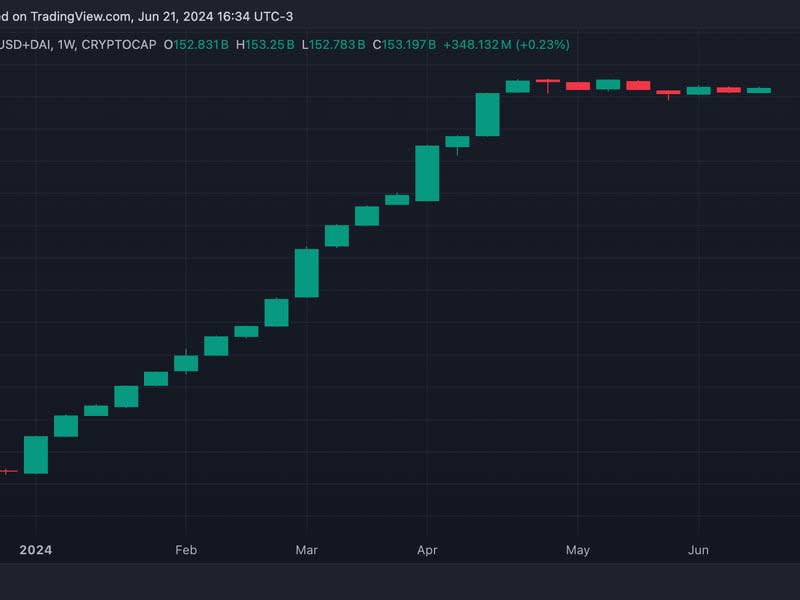This Is Why Altcoin Investors Struggle Despite Bitcoin, Ether Sitting Near Yearly Highs
Crypto majors such as SOL, AVAX, APT, SUI saw 40% to 70% corrections over the past months, weighing on altcoin sentiment, while BTC and ETH are down only 15% from their yearly highs.
Venture funds are under pressure to sell tokens to realize profits on their investments made in the past years, Markus Thielen noted.
The lack of capital inflows to crypto markets "has particularly bad implications for tokens with large upcoming unlocks as well as new [tokens] and airdrop programs," Anagram partner David Shuttleworth said.
The cryptocurrency market is undergoing a healthy consolidation after a massive run-up from October to March – at least for those who invested in the two largest digital assets.
For those who hold smaller cryptocurrencies, though, this is a brutal correction, with sentiment in crypto social media circles resembling bear market despair.
While bitcoin {{BTC}} and Ethereum's ether {{ETH}} are only 15% below their yearly highs, several crypto majors like solana {{SOL}} and avalanche {{AVAX}} are down 40% to 50% from their March peaks, while layer-1 challengers sui {{SUI}} and aptos {{APT}} have cratered 60% to 70%.
Good advice for pure ultra long time frame investors, but I operate both trading and venture books
I believe the cycle is over for 99% of alts,
Hold what makes sense to hold for multi year/decade investments— Andrew Kang (@Rewkang) June 21, 2024
Selling pressure from venture funds with broadening supply token unlocks, lack of fresh inflows to crypto and seasonal trends all contributed to weakness in altcoins, a term used to describe cryptocurrencies beyond the biggest ones like bitcoin and ether.
High dilution
Many altcoins experience a constantly diluting supply of tokens via unlocks and distributions scheduled for years ahead. This is because most of the tokens are locked up, bought by early investors or earmarked for ecosystem developments and grants.
For example, Ethereum layer-2 network Arbitrum's token {{ARB}} is nearing its all-time low price from last September, even though its market capitalization has risen to $2.5 billion from $1 billion because of a massive increase in its supply.
Another example is solana, whose supply is inflating by 75,000 tokens, worth some $10 million at current prices, every day.
"Unlike equities which have a constant passive bid from ETF inflows and bond buybacks, crypto, and in particular altcoins, have the opposite – a constant stream of sell pressure," Quinn Thomson, founder of crypto hedge fund Lekker Capital, noted in an X post.
A significant portion of the selling pressure comes from venture capital funds realizing profits on their early investments in projects launched over the past years.
"Venture capital funds invested $13 billion in Q1 2022, while the market turned into a steep bear market," Markus Thielen, founder of 10x Research, said in a report earlier this week. "Those funds are now under pressure from their investors to return capital as artificial intelligence (AI) has become a hotter theme."
When the market's appetite for the smaller, more speculative crypto assets is dwindling and trading volumes are falling – like in the past few months – there's not enough demand to absorb this supply shock.
Lack of fresh inflows
Liquidity inflows to crypto markets have also stalled or even reversed over the past weeks, shown by the market value of stablecoins, which are mostly used as an intermediary for crypto trading.
The combined market capitalization of the four largest stablecoins – Tether's USDT, Circle's USDC, First Digital's FDUSD and Maker's DAI – has been flat since April after a $30 billion expansion earlier this year, per TradingView data.

Stablecoin balances on exchanges – which translates to dry powder for traders and investors – decreased $4 billion to the lowest level since February, David Shuttleworth, partner at Anagram, pointed out in an X post citing Nansen data.
"This has particularly bad implications for tokens with large upcoming unlocks as well as new [tokens] and airdrop programs," Shuttleworth said.
Recently launched tokens of blockchain bridge Wormhole (W), yield-bearing synthetic dollar protocol Ethena (ENA) and layer-2 network Starknet {{STRK}} all plummeted roughly 60% to 70% in price from their respective highs and will face billions of dollars worth of tokens being distributed in the coming years.
Seasonal trends have been also bearish for smaller tokens, with June usually being a down month for altcoins.
TradingView data shows that the aggregated market cap for crypto assets excluding BTC and ETH, captured by TOTAL.3 metric, saw a decline in every June during the past six years.
This month is on track to be no exception, with TOTAL.3 down 11% to date.

 Yahoo Finance
Yahoo Finance 